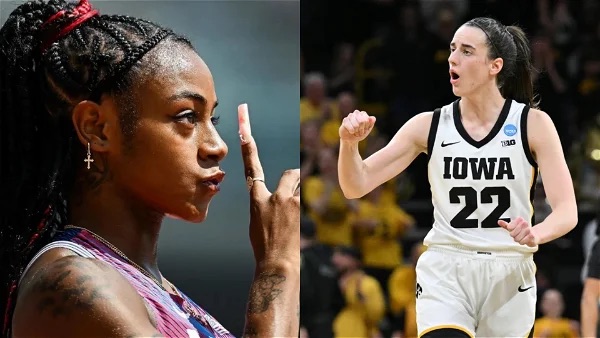
In recent sports discussions, the exclusion of Caitlin Clark from the USA National Women’s Basketball team has drawn parallels to Sha’Carri Richardson’s past experience with the Olympic team. Both cases have sparked significant debate about the criteria and politics involved in team selections, and these discussions also bring to light the complex racial dynamics at play.
First, let’s acknowledge Sha’Carri Richardson’s journey. Her public humiliation and exclusion from the Olympics, only to return stronger and more driven than ever, is nothing short of remarkable. Shannon Sharpe, a well-respected sports analyst, highlighted the resilience and determination it took for Richardson to overcome such adversity. Sharpe emphasized, “To be able to come back from the scrutiny and the harsh criticism, and perform at the highest level, speaks volumes about her character and tenacity.” This sentiment is echoed across the sports world, recognizing the depth of her accomplishment.
Richardson’s story is not merely a comeback; it’s a narrative of overcoming immense personal and public challenges. The scrutiny she faced went beyond the typical “block out the naysayers” advice often given to athletes. Her journey required navigating a landscape devoid of support, in a metaphorical and literal sense. Despite this, she managed to refocus on her passion and achieve what many deemed impossible.
Now, let’s shift the focus to Caitlin Clark. Clark’s omission from the USA National Women’s Basketball team raises several questions. While her talent is undeniable, the decision to leave her off the roster has stirred controversy. Is she statistically better than the veteran WNBA players currently on the team? This is a point of contention that many analysts are eager to explore. Some argue that her presence alone could bring significant attention and entertainment value to the team.
Shannon Sharpe and other sports analysts have weighed in on this issue as well. Sharpe pointed out, “In sports, it’s not just about the numbers. The impact a player can have goes beyond the stat sheet. Caitlin Clark’s popularity and the excitement she brings could be a huge asset to the team.” This perspective is shared by many who believe that sports teams should consider the broader impact of a player’s inclusion.
Sports analyst Stephen A. Smith also commented on the situation, noting, “Caitlin Clark is a phenomenal talent. Her exclusion seems puzzling, especially when considering the marketability and fresh energy she could bring to the team.” Smith’s view underscores the multifaceted nature of sports team selections, where talent, marketability, and team dynamics all play crucial roles.
However, it’s impossible to ignore the racial dynamics that may be influencing these decisions. Sha’Carri Richardson, as a Black woman, faced not only the usual pressures of athletic performance but also the added scrutiny and biases often directed at Black athletes. The intersection of race and gender in her public treatment cannot be overlooked. The harsh criticisms and sanctions she faced highlight a broader issue within sports where Black athletes are often subjected to more severe consequences and public scrutiny.
Caitlin Clark, a white athlete, might be experiencing a different kind of scrutiny and set of expectations. While her exclusion from the team has sparked debate, it is essential to consider how race plays a role in the perception and treatment of athletes. The public and media narratives surrounding athletes of different racial backgrounds can vary significantly, influencing public opinion and, potentially, selection decisions.
In comparing Clark’s situation to Richardson’s, we must acknowledge these racial dynamics and their impact on athletes’ careers. Both women have shown exceptional skill and dedication, yet their paths have been marred by decisions that many find controversial. While Richardson has had the chance to prove herself again, Clark is at the beginning of a similar journey, where public and professional support will be critical.
In analyzing these cases, it’s essential to consider the broader implications for sports governance and athlete support. The criteria for team selection must be transparent and inclusive, ensuring that decisions are made in the best interest of the sport and its growth. Richardson’s story serves as an inspiring example of overcoming adversity, while Clark’s situation raises important questions about the factors influencing team compositions.
Ultimately, the discussion around Caitlin Clark and Sha’Carri Richardson highlights the need for a balanced approach in sports management. Talent, resilience, and marketability should all be considered to create teams that not only excel in their performance but also inspire and engage fans. The sports community must continue to support and uplift athletes, recognizing their contributions and ensuring fair opportunities for all.
The cases of Richardson and Clark also call for a broader dialogue about the role of race in sports. We must strive to create an environment where all athletes, regardless of their background, are given equal opportunities to succeed and are judged solely on their merits. This approach will not only enhance the integrity of sports but also promote a more inclusive and supportive culture for future generations of athletes.
In conclusion, there isn’t necessarily a correct answer to the complex issues surrounding the selection of Caitlin Clark and Sha’Carri Richardson. What matters most is how we prioritize the crucial factors in these decisions and ensure that we apply these standards consistently. We must avoid excusing some athletes while unfairly crucifying others. Only by holding everyone to the same standards can we achieve fairness and integrity in sports, fostering an environment where every athlete has the opportunity to thrive.
